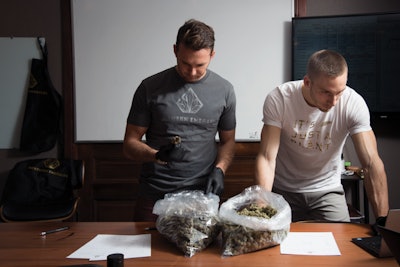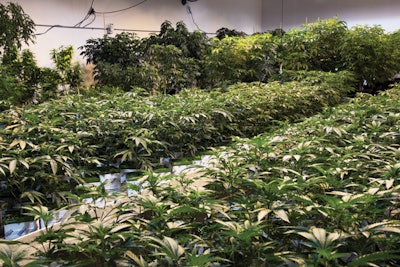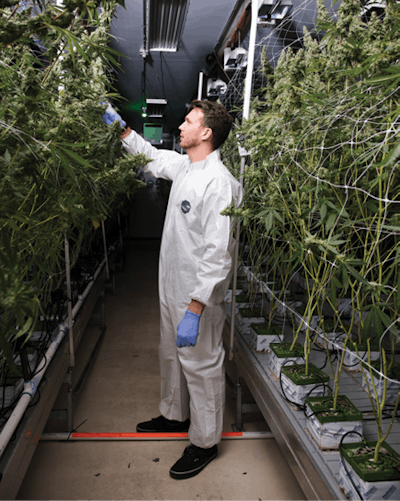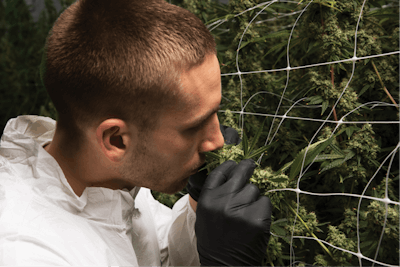
Cody Stross has been working persistently for years to be head of one of California’s top cannabis brands and see his products sold in more than 80 dispensaries across the state.
The Humboldt County-based company officially launched in 2015 and received its county permit in 2016, but Stross, the company’s founder, says the Northern Emeralds dream started closer to 2008, at a time when the Emerald Triangle was more familial, more congenial and definitely less formal. Business deals were more often sealed with handshakes on dirt roads than with lawyers and written contracts.
In this scene, Stross found three issues on which he wanted to capitalize: a lack of professionalism, a lack of quality and a lack of consistency. “In Humboldt County and as a cultivator in California cultivating under [Proposition] 215, there was always a lot of disconnect from 99 percent of the farmers in the state,” Stross says. “There was a disconnect from the farmer and the consumer.”
Formalizing business in California would not only represent a dramatic culture shift, but would give Stross’ team the information and data it needed to mend that disconnect and better understand the marketplace-and, ultimately, build a quality-focused brand.
Patiently Waiting
Building that brand would take time, however. The son of a Formula One-driver-turned-smuggler, Stross wasn’t equipped with a longstanding reputation for cultivating cannabis, nor the backing of an established farm when he first started shopping his product around different dispensaries in 2008.
As such, he was different than other Emerald Triangle cultivators, and securing meetings with dispensary owners was never easy. Stross remembers sitting in dispensaries for hours just to meet with a purchasing manager, only to be turned away. Other dispensaries were like boys’ clubs, he says: If you didn’t have an in, you were out.

But what Stross did have was persistence and a nose for high-quality product. With that, he returned once a week to those dispensaries that rejected him, until he got a meeting. “Oftentimes it would take five, six, seven, eight visits to get in, and then finally when we got in, we’d always be invited back because of how good our product was,” he says.
Stross wasn’t just looking to get in the door—he wanted to stay in the store. After the first meeting, the focus was making “sure that we were professional. … So, showing up on time, having that consistency, listening to the needs of our clients and responding to them, really honoring them and seeing them as partners,” he explains, adding that “professionalism and consistency … has been the backbone of our business in a lot of ways.”
Stross and his team continued to grind over the next six years, visiting dispensaries and introducing themselves to new markets, before catching their big break in 2014 when a local media organization ran a two-page photo spread of the company’s flagship cultivar, Titan OG. This was the creation of Northern Emeralds’ master artisanal craftsman Alex Knappitsch, and it earned a score of 9.6 for “nearly perfect cannabis,” Stross recalls. “That was the real wake-up call for us that we had something special and that we needed to move with it.”
That quality is derived from Stross himself, who describes himself as “an extreme connoisseur of the flower,” and he believes every flower has its own story to share. The smells consumers and patients encounter when opening the bag, the textures they feel when handling their product, the volatilization of the terpenes when the flowers are cracked open-all of it exposes how the product was made.
“[It] tells you a whole story about the life of that flower—whether it was run in a room that was too hot; whether it was over-fed with nutrients; whether it was run at the right temperature and humidity; whether it was bagged and cured properly, and treated properly; whether the trimmers handled it correctly. … So my obsession is with understanding that story, and our purpose in a big way is to create a beautiful story, time and time again, from every batch of flower that we produce,” he says. The company incorporated the next year, and the California market was officially introduced to the Northern Emeralds brand.

Art Married with Science
While Stross’ passion for quality helped put Northern Emeralds on the map, the company’s next challenge was to scale up its operations without losing that quality. To do so, the team needed to figure out “a way to quantify quality,” the founder says.
One of the things he noticed was a disconnect between his buyers and his sales staff. At the time, his employees hadn’t discovered a way to accurately describe the product without using subjective terms.
Enter Tyler Simmons, Northern Emeralds’ head of cultivation.
To complement Stross’ artistic view of the plant, Simmons says he has a more scientific approach to cannabis.
Six months after incorporating, the Northern Emeralds team developed an in-house, 12-part grading system for cannabis flower that judged everything from taste and smoke-ability to the smell and the plant’s effects. Through time, the team has been able to hone its skills to where the company’s judges (including Stross and the intake team) are nearly always within the standard 3.5-percent margin of error from one another in every category, according to Stross.
This grading system allows Northern Emeralds to better understand what patients need by comparing the company’s quantitative analyses with patient and dispensary buyer patterns and sell-through rates, eventually leading the company to leverage that information “backwards in the cultivation,” Simmons says.
For example, Simmons ran an experiment where he manipulated the growing-medium-to-canopy ratio, with the intuition that it would increase yield. “[When] we [looked] at the data later on, we [saw] that it actually decreased … the overall average flower size,” he says, adding that these tests are important to perform. “Otherwise, you can really lead yourself down the wrong path and end up with methodologies that aren’t getting you where you want to be.”

Serving the Seed
Stross and the Northern Emeralds team take these meticulous steps to better “serve the intent of the seed,” as the founder says. Stross believes that there is “perfection” in every seed and it’s the team’s job to ensure the plant has “an atmosphere in which it had the opportunity to become the best expression of itself possible.”
The key to finding that perfection is ensuring the seed receives a good, healthy start by developing a strong root system.
“There’s nothing better than picking up a plant and seeing the bottom of the root mass just covered with bright, white, fuzzy roots,” Simmons says. “That’s how you know that you’ve got a plant that is producing at maximum capacity.”
While he looks at the roots’ color (brown roots are a sign that the plant is sick or dying, Simmons says), the fuzz is what he is really looking out for. “[Part] of that has to do with a symbiotic relationship with mycorrhizae, which is fungi that … colonizes the roots and helps nutrient absorption, among other things.”
Simmons has learned to not just look at the bottom of the rockwool cubes when he inspects root balls, he’ll also peel back the plastic and look at the sides. That is because over-irrigation signs wouldn’t necessarily be apparent on the bottom of the cube, as the water will pull the roots down and spread on the bottom without filling the entire media, Simmons says, adding that “if you check all of the sides of the blocks and you’ve got roots everywhere, then you know you’re golden.”
To achieve strong root health, Northern Emeralds focuses on precision irrigation through automation. “We automate and schedule everything so that water, oxygen and nutrients are frequently and regularly replenished in the root zone,” Simmons says.
Medium choice also plays a big role in Northern Emeralds’ watering processes. Simmons prefers rockwool because of its capacity to hold oxygen and water, and how easy it is to measure its nutrient concentration and water content levels, he says.
Excellence Takes Time

Striving for perfection takes time, which is why Northern Emeralds carries such a limited number of cultivars: Titan OG, Sapphire Kush and Purple Champagne are its main strains currently in the California market, but the company has six different genetics available.
“You can only be excellent at a few things at a time,” Stross explains. “There is such complexity to delivering a really connoisseur … flower that we really wanted to limit it down and expand carefully our selection of genetics specifically because each one is so very different from the next.”
Serving the intents of separate cultivars means creating and optimizing distinct growing environments. Separate rooms are dedicated to each cultivar in Northern Emeralds’ indoor facility, and, as is common practice in the industry, charts are placed on doors to let workers know which strain grows inside.
But Northern Emeralds goes one step further. Weeks corresponding to the room’s age are marked off on one axis, while the other axis contains all of the environmental variables: day temperature, night temperature, day humidity, night humidity, CO2 levels, irrigation levels, etc. “And [the information] in all of the boxes in between those two axes … has over time, been slowly customized so that it’s specific to what that strain wants at that particular moment in time,” Stross says.
Choosing those cultivars is as diligent a process as growing them. Northern Emeralds works with a few select breeders who bring different phenotypes to the team. Based on Stross’ and Simmons’ intuition and experience, the team chooses a phenotype that shows potential. Once selected, the new plants are immediately quarantined for up to two months before entering another grow room to ensure that no pest or health issue is present in the plant.
Once the team is confident it has optimized the strain, market testing begins and “that’s a long process because what we think is good is not necessarily what our patients and clients think is good,” Stross explains.
Harking back to the team’s early days, “We bring down samples all across the state, and we sit in the buyers’ rooms with the buyers and we get feedback from them, [as well as] the budtenders, the patients. We really try [to] go out as far as we can and get as much feedback as we can,” he says. The company may test 10 new strains at a handful of dispensaries to then focus on further developing only two cultivars. Further testing determines which of those joins the company’s regular stable.
Patients in Northern California have different needs and tastes than those in Southern California, which is why Northern Emeralds’ 12-part grading system is all-the-more important to understand those distinctions, Stross says.
With those grades, “we can diagnose … and understand if someone says, ‘Hey, I don’t like this,’ they’re probably talking about this particular category [that five] other people in that area agree with. … Now we know that the response in LA might be different than the response in Sacramento,” he continues. It’s important to note that Northern Emeralds only works with one variation of a cultivar at a time to maintain consistency in its test results.
One trait that Northern Emeralds has found that the entire state can agree on is quality. The higher the quality, the more universally liked a product is.
You Trim Hedges, but Manicure Cannabis
Stross, Simmons and the rest of the team know that the look and feel of the flower is just as valuable to the consumer experience as the actual consumption; it’s another aspect that they believe sets the brand apart from the competition. Even the way they talk about trimming, or “manicuring” as they call it, is different than most.
“We want it to show up to you as though it grew without any leaves, it has all its pistils intact, no stem, like it just was a manifestation of perfection right out of the grow room and in your hand, perfectly manicured and never touched by anyone,” Stross says.
Northern Emeralds developed manicuring standard operating procedures (SOPs) for its strains, and has a grading system to determine into which quality tier each bud fits. Manicurists must wear gloves when handling the product, wear face masks to avoid contamination, and the work room is environmentally controlled and positively pressurized to blow away any potential contaminants. High-efficiency particulate air (HEPA) filters clean the air throughout every step of the process right through packaging.
The company doesn’t hire part-time trimming staff or outsource trimming. Instead, manicurists are full-time employees with benefits. The same applies to managers, growers and administrative staff because, as Stross says, “it’s of equal importance that we all do a great job.”

Things to Come
Northern Emeralds will need to continue doing a great job now that California has fully legalized cannabis. But Stross believes that the company already has a head start on most of the competition thanks to its years’ worth of data about the California consumer. He says companies who haven’t studied the market are going to have to face “the most picky cannabis connoisseurs out there.”
Stross expects there will be more regulatory changes in the coming months as the industry and regulators adapt to this new reality. “That’s been one of the biggest difficulties for us,” he says. “The laws are changing, and you have to adapt quickly, and a lot of that means that you have to go back to the drawing board once you thought you were complete.”
Indeed, counties and municipalities are still grappling with permitting and zoning issues. LA only passed emergency ordinances regulating the cannabis industry on Nov. 20, just six weeks before the program was set to go live, and multiple jurisdictions have placed temporary moratoriums on cannabis businesses to have more time to develop rules.
Ultimately, the biggest hurdle for the California cannabis industry in 2018 will be black and gray market businesses becoming legitimate, according to Stross. If cultivators go into this new environment thinking that old-school business practices are going to work, Stross says they are in for a “harsh awakening.”
“The business that we are in today is not the business that you were in last year or the year before or the year before that and since it started in ’96,” he says. “When you are compliant, when you do have your permits, now you’re sitting in a car you haven’t ever driven before. It’s a different race.”
But Stross knows a bit about racing from his father’s past career, and with one foot on the gas and one on the clutch, he’s ready to go.


















